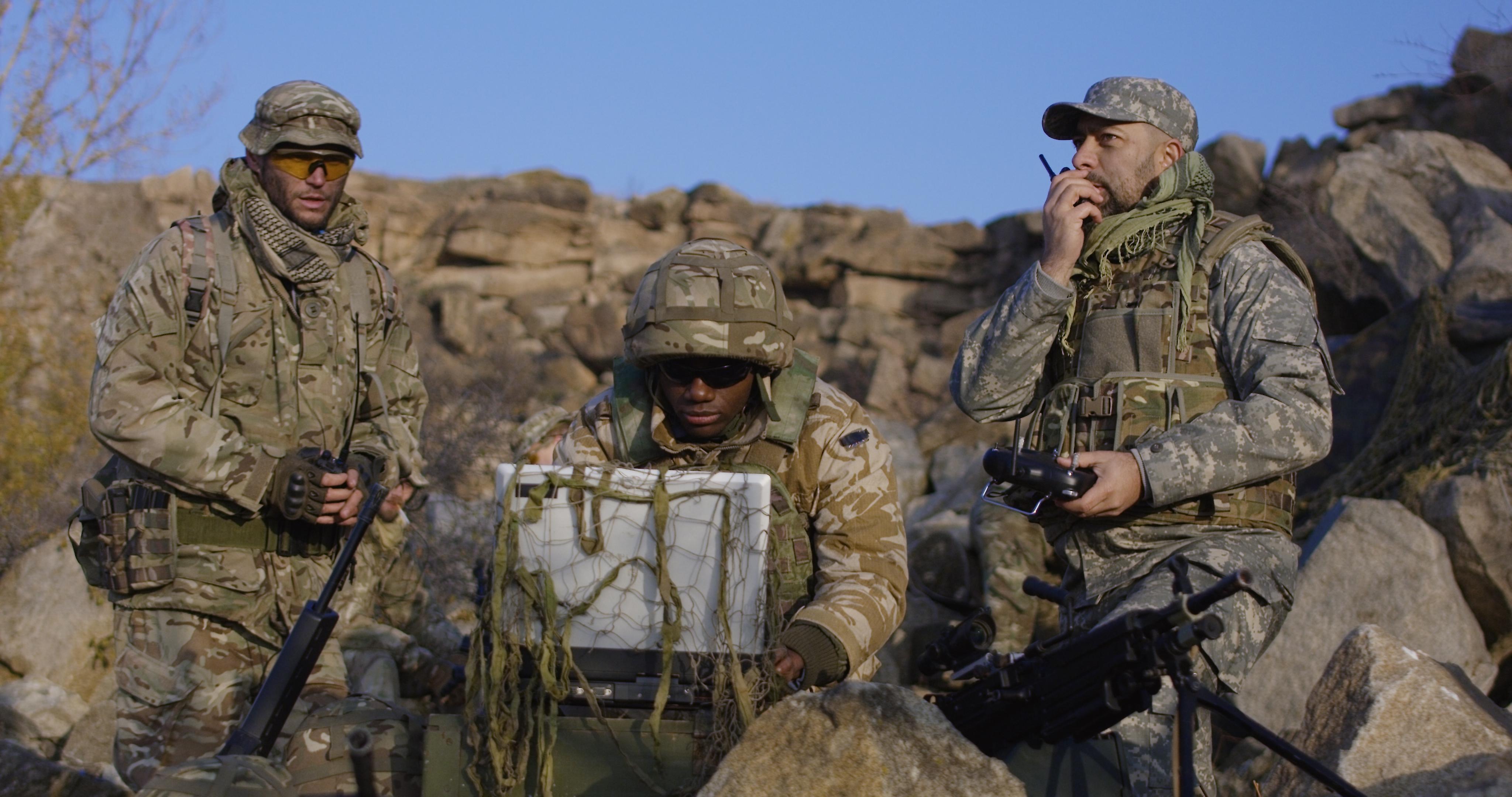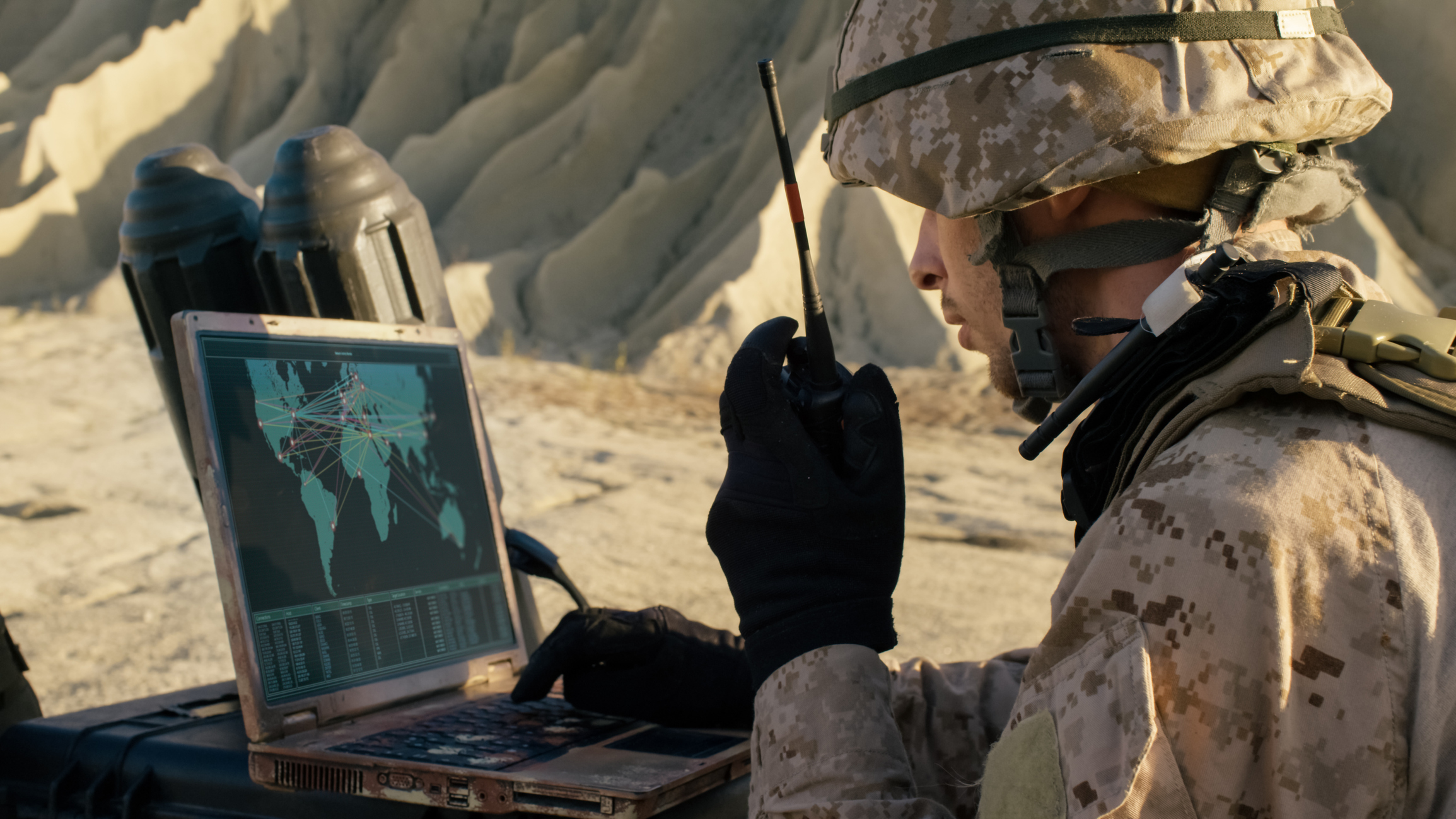- PreviousUncertainty Demands Interoperability: The Need for a Common Operating EnvironmentPrevious:Uncertainty Demands Interoperability: The Need for a Common Operating Environment
- NextNetwork-Enabled, Not Network-Dependent: Leveraging the CloudNext:Network-Enabled, Not Network-Dependent: Leveraging the Cloud
C4ISR: The Military's Nervous System
StartWhen it comes to supporting military operations, history has shown that effective communication and information-sharing processes are just as important as ordnance, strategy, and logistics.
While information creation, communication, analysis, and exploitation have always played a key role in military strategy and operations, recent rapid progress in information and communication technologies has dramatically enhanced the strategic role of situational awareness.
The “nervous system” of the military, the collection of subsystems used to maximize situational awareness, is referred to as C4ISR—command, control, communications, computers, intelligence, surveillance, and reconnaissance. C4ISR technologies are the bedrock of any mission, and the components must work in tandem to effectively enable the “muscle” side of the military—weapons, platforms, and troops. C4ISR networks collect massive amounts of data from multiple sensors, databases, and other sources worldwide. The data is fused, processed into usable information, and shared securely among authorized users.
C4ISR systems are becoming increasingly important for mission success. Read on to learn how the changing nature of warfare is informing the DoD’s overarching strategy for maintaining military dominance on today’s battlefield.
Contents
- Changing Operational Environment
- Uncertainty Demands Speed and Agility
- Uncertainty Demands Interoperability: The Need for a Common Operating Environment
- The Integrated Tactical Network
- Network-Enabled, Not Network-Dependent: Leveraging the Cloud
- Future Focuses: AI
- China's Rise in the C4ISR Race
- Barriers to Optimal C4ISR Systems
1/8
Changing Operational Environment
The increasing breadth and depth of information, the accelerating speed with which information flows and weapons can be deployed, and the proliferation of interoperable digital devices have driven home the need for the DoD to develop and deploy more modern C4ISR capabilities.
Because U.S. military systems are typically expensive, highly specialized, and time-intensive to build, they quickly become obsolete in today’s environment—leaving the United States more vulnerable to attack. This traditional model also means most DoD systems are too costly to be easily replaced: The Army’s legacy battlefield intelligence-sharing system, for example, has been in development for more than a decade and could cost as much as $28 billion over the next 20 years.
DoD systems were built for a more predictable past—not the uncertain and ever-changing present they now face. In an effort to adapt, military leaders are not only changing the way they plan and execute, but are also revamping the systems that enable their planning to begin with.
We’ve got to be able to conduct distributed mission command in the observe, orient, decide, and act at a pace faster than our adversary. Our command posts … have to be mobile and secure, and they’ve got to be able to move rapidly in a very violent, very lethal fight ... We’re going to have to move, we’re going to have to move fast, and we’re going to have to be connected when we move. That’s the network we’re trying to deliver.Maj. Gen. Peter Gallagher, director of the Army’s network cross functional teamContents
2/8
Uncertainty Demands Speed and Agility
The diffusion of advanced technology and the accelerating speed of technological innovation has far-reaching effects, from increasing the number of enemies the United States confronts to reducing the time military leaders have to receive, analyze, and act on information.
Today, the United States faces threats from a growing number of adversaries, from middleweight militaries to non-state actors—all of whom are able to leverage a far greater range of tools to disrupt DoD missions. Compounding this challenge is the speed with which weapons can now be deployed. This increase in operational tempo and the range of weapons employed means that, despite the best available intelligence information, surprises will occur—and there will likely be only a brief period of time between indications of trouble and force employment.

To meet the demands of a continually changing operational environment, the DoD is prioritizing the creation of an agile network that is as mobile as the forces, elements, and the organizations it supports—without degraded information quality or flow. The Army, for example, recently launched a pilot effort known as the 5th Generation Technical Insertion (5th Gen TI), which aims to increase mobility by reducing the amount of physical equipment teams must use and by leveraging more virtual machines and software-based infrastructure.
These new systems will significantly improve tactical operations. On the battlefield, nine times out of 10 we have to improvise our plan and we need to move, and move quickly. If we can get the network up in minutes [versus hours], it enables us to move that much faster.BJ Labrone Jones, information technology specialist for the 1st ABCT, 3rd IDContents
3/8
Uncertainty Demands Interoperability: The Need for a Common Operating Environment
The complex, dynamic nature of today’s missions is also transforming the way commanders engage in planning and execution. Whereas in previous frameworks, commanders interpreted the battlefield along fixed variables (i.e. across time, geography, and function or domain), the battlespace today now spans multiple, interrelated theaters. This forces commanders to rely not on prearranged decision-making, but on parallel—rather than sequential—planning in real-time.
Today’s environment also requires the collective capabilities and efforts of multiple organizations. Unfortunately, traditional C4ISR systems weren’t built with interoperability in mind—in the past, they were designed to meet mission-specific requirements and to solve a particular set of problems facing an organization. This specialized functionality limited the DoD’s ability to communicate from one system or platform to another, and information remained stovepiped within missions.
We have systems that can show us volumes of data on fires, logistics, or friendly and enemy force locations, yet we don’t have one system that brings the entire picture together. We have constantly evolving software, but some tools require too many clicks or permission levels for warfighters to actually find their best features. We have great communications inside combat and tactical vehicles, but they each come with their own monitors and other hardware, creating a challenge for operators in tight quarters.Army Maj. Gen. Daniel Hughes, Army Program Executive Office for C3 TacticalTo reduce the complexity in existing mission command suites, the Army is developing the Common Operating Environment (COE) for mission command hardware and software systems—a set of standards and applications that improve distributed mission command and enable rapid decision-making (Observe, Orient, Decide, Act). This effort consolidates all warfighting functions in the dismounted, mounted, and command post computing environments to provide a simple, intuitive, and integrated common operating picture.
Contents
- NextNetwork-Enabled, Not Network-Dependent: Leveraging the CloudNext:Network-Enabled, Not Network-Dependent: Leveraging the CloudPreviousUncertainty Demands Interoperability: The Need for a Common Operating EnvironmentPrevious:Uncertainty Demands Interoperability: The Need for a Common Operating Environment
4/8
The Integrated Tactical Network
Despite the Army’s efforts, significant hurdles to true network interoperability remain. According to the Director of Operational Test and Evaluation’s (DOT&E) annual report, “The current capability of an integrated network to enhance mission command is diminished due to pervasive task complexity.” DOT&E found that the Army’s systems require assistance from supplying vendors—of which there are many—to connect to Army networks. “This dependency,” it notes, “Corresponds directly to the excessive complexity of use of network components.”

The Army is hoping to address this with its Integrated Tactical Network (ITN)—not a new or separate network, but rather, a “concept that incorporates the Army’s current tactical network environment (applications, devices, gateways, network transport) with commercial-off-the-shelf (COTS) components and transport capabilities to enable communications in denied, intermittent, and limited bandwidth environments.” According to Army leaders, by merging systems, the new approach will allow forces to be more expeditionary and mobile.
One of the ITN’s key features is the incorporation of a Secure but Unclassified (SBU) communications architecture into the network. This allows soldiers to leverage commercial cellular networks—such as 4G, LTE, and WiFi, along with other commercial wavelengths—to communicate.
When we changed over from having a classified network to [SBU], it changed the classification of our devices, which then changed the opportunities of what networks we can connect to. It is all about how much data you can move and how you can connect it and interoperate between Soldiers. You can now stream video from an unmanned aerial vehicle, you can send pictures—we can do a lot. It opens up the aperture of things we can do with this software.Maj. Ken Elgort, Assistant Program Manager with Program Executive Office SoldierContents
5/8
Network-Enabled, Not Network-Dependent: Leveraging the Cloud
Transforming the Army’s network will require better leveraging of cloud technologies.
The Army accordingly plans to invest almost $1 billion in cloud, data, and artificial intelligence over the next five years—an effort, Army Secretary Ryan McCarthy said at an October conference, to “move the Army from the industrial-age processes to the information age of leveraging data as a strategic asset and utilizing private sector technology.”
Why do we want to go to the cloud? Because you get better synthesized data. Sensors are going to be ubiquitous on the battlefield. They’ll provide such masses of data that unaided human brains and traditional staff processes can’t collect it all in one place, let alone make sense of it: “It’s got to be synchronized by tools such as artificial intelligence and cloud-based computing.Lt. Gen Eric Wesley“If I am a warfighter, I want as much data as you could possibly give me,” said the head of the Joint Artificial Intelligence Center, Air Force Lt. Gen. Jack Shanahan. “It’s really hard for me to do that without an enterprise cloud.”
However, warned Lt. Gen. Eric Wesley in a recent conversation with reporters, troops won’t necessarily have access to the cloud all the time: “You can imagine where a given [unit] will be off the net for a period — maybe go dark, not unlike the way submarines operate now.”
While disconnected, troops will have to make do with whatever data they’ve already downloaded, perhaps to a backpack mini-server with built-in AI. Then, Wesley continued, “when you’re back up on the net, you might need to do a download, adjust your algorithms, adjust your data.”
“You’re going to have balance both cloud computing and computing at the edge,” Wesley said. “It’s absolutely a form of maneuver.” Transmitting and going silent, uploading and downloading, will need to be as well-practiced and intuitive as digging in a hasty defense or laying an ambush.
The beauty of that, according to Wesley, is not only getting access to all the benefits of the cloud down to the very edge of the battlefield, but having collected data in the central cloud, where everyone can benefit from it.

Today, troops from different branches can usually talk to one another over the radio, but that’s a slow and error-prone way of relaying detailed data, such as the locations of friendly forces or hostile targets. (And it’s a matter of life or death to avoid getting those two things mixed up). The military has multiple systems for transmitting data directly from one computer to another over radio and landline, but each focuses on a specific function—such as navigation, logistics, or artillery planning—and don’t connect with other systems in the same service, let alone with those of other services. All too often, data has to be laboriously retyped by hand, or simply scrawled on sticky notes and passed from one staff officer to the next.
According to the Air Force's Brig. Gen. David Kumashiro, “We don’t have that machine to machine connection. So that’s one of the other areas that we will specifically target as we build out this Advanced Battle Management System, which is really what I would call the technical engine behind our particular Multi-Domain Command & Control [approach], ensuring that Army systems, Navy systems, Air Force systems speak to each other.”
Making a common set of C2 apps available as cloud services will further enhance mission effectiveness and better enable commanders to access imagery and other situational information to develop, share, and reconcile operating pictures.
Contents
6/8
Future Focuses: AI
Artificial Intelligence (or AI) is poised to feature prominently in the rollout of next-gen C2 systems. Its application will help deliver critical system support under severe time constraints, as well as recommend alternative courses of action to help human operators navigate a labyrinth of decision points.
We want A.I. to increase operational effectiveness, accelerate integration with autonomous systems, and enhance efficiency across the department.Lt. Gen Jack Shanahan, JAIC directorIn order to facilitate the development of AI technologies, the department created the Joint Artificial Intelligence Center (JAIC) in 2018 and rolled out a new department-wide AI strategy—to be spearheaded by JAIC. This strategy is comprised of four focus areas:
1) Delivering AI-enabled capabilities that address key missions;
2) Partnering with leading private sector technology companies, academia, and global allies and partners;
3) Cultivating a leading AI workforce; and
4) Leading in military ethics and AI safety.
To accomplish these goals, the JAIC aims to foster an environment better suited to experimentation and risk-taking, provide current employees with AI training, and work with international partners to develop a global set of military AI guidelines.
Contents
7/8
China's Rise in the C4ISR Race
While many governments across the globe are working to bolster their military’s C4ISR capabilities, China is by far the United States’ biggest competitor and threat. Over the past decade, Beijing has worked to gain expertise in information warfare, thereby increasing China’s ability to sabotage U.S. military communications and steal classified information from military and defense contractors.

In 2015, China demonstrated its dedication to information warfare by establishing the Strategic Support Force, which aims to “integrate reconnaissance, offense, and defense” by “centralizing space, cyber, electronic warfare and psychological warfare missions under a single organization.”
The [Chinese military] may seek to use its cyberwarfare capabilities to collect data for intelligence and cyberattack purposes; to constrain an adversary’s actions by targeting network-based logistics, communications, and commercial activities; or to serve as a force multiplier when coupled with kinetic attacks during armed conflict.Military and Security Developments Involving the People’s Republic of China 2019, DoD's Annual Report to CongressBeijing’s determination to dominate in the information warfare arena has led to the country’s fast adoption of C4ISR technologies. In fact, this rapid procurement and development is predicted to make the Asia Pacific region the largest market for C4ISR tools by 2025.
Contents
- Start Over
8/8
Barriers to Optimal C4ISR Systems
While the DoD has signaled development of C4ISR capabilities as a top priority, a number of obstacles must be overcome in the years ahead if it hopes to maximize innovation.
The first of these barriers is the department’s arduous acquisition process. Historically, the DOD’s bureaucratic, risk-averse nature has struggled to accommodate the rapid pace of innovation seen in the private sector. Consequently, the DoD often finds itself utilizing outdated technology and playing catch-up. In order to quicken the acquisition process, the department’s Defense Innovation Board suggests adopting a multi-track acquisition system and making better use of current waivers and acquisition exemptions.
.jpg)
The second obstacle involves appropriations. The DoD’s innovation budget is limited by what is appropriated by Congress in the National Defense Authorization Act (NDAA). Because the department’s budget has to be allocated to specific projects spelled out in the NDAA, there is little flexibility to alter processes to quickly fit the ever-changing needs of the department. In order to counter this limitation on innovation, money should be granted to universities and laboratories without being connected to a specific project. This would then give innovators the freedom to experiment, take risks, and make timely alterations.
Contents

